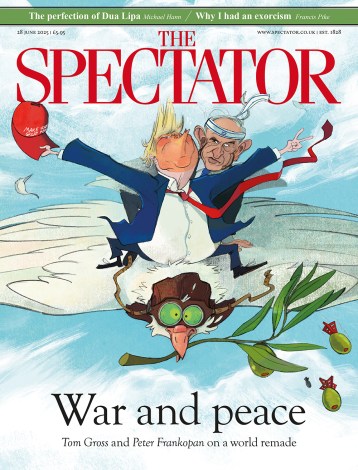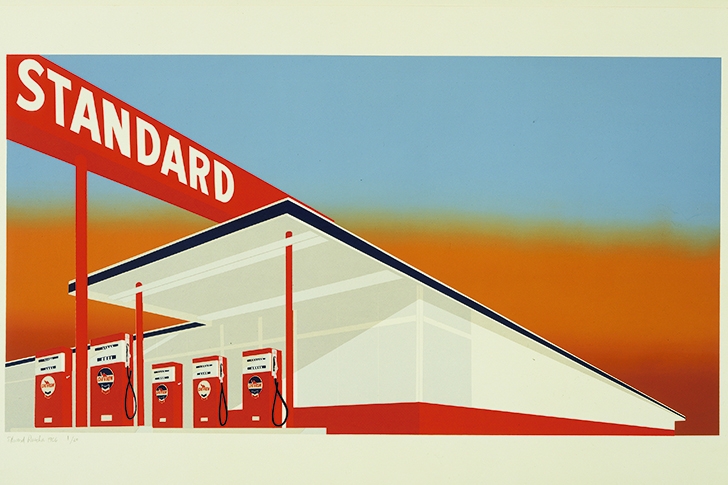The American dream was a consumerist idyll: all of life was to be packaged, stylised, affordable and improvable. Three bedrooms, two-point-five children, two cars and one mortgage. The sense was first caught by Alexis de Tocqueville in Democracy in America (1835–40), where he talks about a people more excited by success than fearful of failure.
We all know when the dream died: on 9 November 2016. People in Brooklyn were crying. In Manhattan they couldn’t breathe. A national angst had been revealed: the land of plenty had become the land of the plenty cross.
But when did the dream start? There was the Jeffersonian trinity of life, liberty and the pursuit of happiness, which was diverted into frontier mysticism, but by the mid-20th century this had evolved into an almost religiose belief in the enhancement of life by ever-increasing consumption of manufactured goods. Chevrolet ergo sum.
Consider this sequence: 1926, ‘mass production’ is mentioned in the Encyclopaedia Britannica; 1927, Raymond Loewy opens the first design consultancy in New York; 1931, the phrase ‘American dream’ is coined by James Truslow Adams, a journalist:
The American Dream is that dream of a land in which life should be better and richer and fuller for everyone, with opportunity for each according to ability or achievement. It is a difficult dream for the European upper classes to interpret adequately, and too many of us ourselves have grown weary and mistrustful of it. It is not a dream of motor cars and high wages merely, but a dream of social order in which each man and each woman shall be able to attain to the fullest stature of which they are innately capable, and be recognised by others for what they are, regardless of the fortuitous circumstances of birth or position.
This dream will one day deliver a streamlined electric kitchen. In the same year, one Neil McElroy of Procter & Gamble invented ‘brand management’ and imagery became the most valuable part of commerce.
There is something of an American season in London. The British Museum’s astonishing new exhibition of prints, The American Dream: pop to the present, neatly complements, and frankly upstages, the Royal Academy’s oil-painting show, America after the Fall, although its curator Stephen Coppel denies the intention. And in May the Design Museum will examine California and what the Sunshine State has done for personal liberty, from LSD to the various iFads.
One aspect of the American dream was born here in the Gold Rush of 1849 and the sense of accident bringing great riches. Experimental lifestyles flourished in Cali because it was the end of the world. Even now, driving through the rich wastes of Culver City or the San Fernando Valley, you think of Gertrude Stein’s ‘when you get there, there’s no there there’. Materiality was not essential: the world’s biggest hotel company, San Francisco’s Airbnb, owns no hotels.
The American dream took many forms, however, several of them absurd. The loopy techno-utopian Buckminster Fuller wanted Americans living in his round ‘Dymaxion’ houses. In 1952 the New York Times had a headline: ‘Architect offers bubble for house. Says plastic “Space Container” with sleeping tents may replace present structure’. Meanwhile, Fuller’s Dymaxion car was so under-engineered that it took off and killed its test driver.
Still, the dream continued to influence real life. And often its coordinates were best understood by grateful immigrants: by the mid-Fifties, a US citizen could lead his entire life surrounded by cars, shavers, toothpaste, razors and cigarette packs designed by Loewy, a Frenchman. The sheer maximal gorgeousness of it all made contemporary gallery art look introverted, so artists began to employ industrial methods in pursuit of their own version of the dream.
In 1962 Andy Warhol started to use silkscreen printing, or serigraphy, precisely because he wanted ‘an assembly-line effect’. He started as a hack commercial artist, drawing shoes for advertisements, then became the most commercial artist of them all.
His mass-produced prints were the result of a baroque collision between brand consciousness and witty self-effacement. At about the same time, Roy Lichtenstein aped the four-colour commercial print process of pulp comics, known as Ben-Day dots. In this dream, mass-produced art was not diminished by multiplicity, but enhanced by it: a movie seen by one person is not much of a movie.
In the British Museum’s spacious new Sainsbury Galleries the exhibition gives exhilarating light and air not just to Warhol and Lichtenstein, but also to every great name in pop art: Robert Rauschenberg, Jasper Johns, Jim Dine, Richard Estes, Tom Wesselmann and Ed Ruscha.
But there are abstractionists and minimalists too, so different in mood from noisy pop. When they took to print, these were not furtive atelier experiments, but, echoing the dream, aesthetic campaigns of great ambition and high purpose. The aim was no less than to establish an international American monopoly on high art, rather as Procter & Gamble had done with soap.
The best work here is contemporaneous with the creative revolution in advertising: artists enjoyed words with their images, as advertisers did. But it was at about this time that the first cracks began to appear, letting harsh daylight into the dreamworld with the publication of critiques about the environment, media and auto industry from Rachel Carson, Daniel Boorstin and Ralph Nader.
Art revelled in the cracks. In Bruce Nauman’s ‘Malice’ of 1980, the dream’s favoured messenger, the neon sign, turns coolly bilious and almost illegible. In Walasse Ting’s poem, accompanying a print of a gun-toting Puerto Rican, America has a ‘brain made by IBM & FBI/ stomach supported by A&P/…love supported by Time & Life/ tongue supported by/ American Telephone & Telegraph/ soul made by 7up…’. Nearly the first thing you see? A print by James Rosenquist, a former billboard painter, his never-before-assembled ‘F-111’ (1974), at 86ft a little longer than the bomber that inspired it.
There is a diminution of artistic and intellectual quality at the end of the show. Wesselmann’s deliciously objectified and cartoonishly ridiculous nipples, as luscious as ice cream, and Estes’s mesmerising hyper-realist diners, so superior to their architectural original, are, in the end, more moving than campaigns about Aids, minority rights and feminism. Artists of the American dream were at their best worshipping trash, ironising the military-industrial complex, enjoying cars, teasing celebrities and mocking death: pleasure, sex and beauty being better inspirations than anguish or blame. Consumerism bests activism.
Can the dream be salvaged in a dismayed, deindustrialised, ethnonationalist America? Maybe, because Trump has a crude apprehension of its magic allure. Meanwhile, if you wanted an example of American exceptionalism, here it is — in the artistic variety and ingenuity on display. And if there is still anyone who doubts the power or beauty of high modernism, a visit to the British Museum is urgently indicated. Pop imagery and minimalist shape-making have acquired the magnificent, aged lustre and enduring value of the Old Masters.






Comments